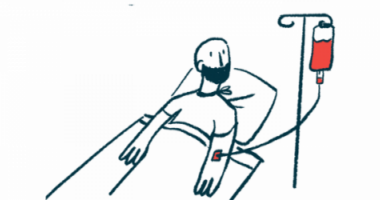Better outcomes seen after switch to Nexviazyme from Lumizyme
Breathing improved with newer therapy for most LOPD patients in real world

Switching from Lumizyme (alglucosidase alfa) to Nexviazyme (avalglucosidase alfa) was shown to improve breathing and motor function for most people with late-onset Pompe disease (LOPD) in a small real-world study.
Many of the improvements, such as those seen in walking ability, were minimal, and did not reach statistical significance. But the researchers noted that the gains seen with a switch to the newer Nexviazyme generally outweighed the losses, and that the change in treatment resulted in an easing of symptoms for some patients.
For one young woman — the first patient in this study to switch treatments — changing to the next-generation enzyme replacement therapy (ERT) after nearly 20 years on Lumizyme allowed her to blow out her birthday candles for two years in a row.
“This study presents evidence that switching from alglucosidase [Lumizyme] to avalglucosidase [Nexviazyme] may be associated with improved outcomes in certain patients with LOPD,” the team wrote.
The study, “Real-world outcomes from a series of patients with late onset Pompe disease who switched from alglucosidase alfa to avalglucosidase alfa,” was published in the journal Frontiers in Genetics.
Study tracked 15 patients ranging in age from younger than 1 to 51
Enzyme replacement therapy, known as ERT for short, is a standard Pompe treatment that provides patients with a lab-made version of the acid alpha-glucosidase (GAA) enzyme, which is missing or defective in those with the genetic disease. Without this enzyme, the sugar storage molecule glycogen accumulates in various tissues, causing progressive damage, especially in the heart and other kinds of muscle.
Lumizyme, sold as Myozyme outside the U.S., was the first ERT approved for Pompe disease. Despite its demonstrated benefits in improving motor function, many patients on Lumizyme reach a functional limit or decline while on treatment. This had been partially due to the incomplete uptake of the ERT into muscle cells.
Nexviazyme is a second-generation ERT, also marketed by Sanofi, that’s designed to deliver the GAA enzyme to muscle cells more efficiently than does Lumizyme, thus boosting glycogen clearance. Clinical trials comparing the two therapies have shown that Nexviazyme is at least not inferior to Lumizyme in improving breathing and motor function.
Still, “there remains a need for more real-world data on patients who switched from alglucosidase to avalglucosidase,” according to researchers at Duke University, in North Carolina.
Their study examined real-world data from 15 LOPD patients who had switched from Lumizyme to Nexviazyme and continued treatment for at least six months. Their ages ranged from less than 1 year old to 51.
Muscle weakness was the most common first symptom for these patients, followed by fatigue, shortness of breath, and muscle pain. All but one was able to walk without assistance. Before switching ERTs, they had received Lumizyme for periods ranging from 2.3 months to 19.1 years. Eight participants received Lumizyme for at least three years and seven for more than five years.
Tests done after switching revealed significant improvements in Pompe-related biomarkers — including reductions in hex4 for glycogen storage, creatine kinase for muscle damage, and alanine aminotransferase for liver injury.
Overall, there were no statistically significant differences before and after switching in the mean distance patients walked in six minutes, a test of motor function known as the 6MWT. However, an examination of individual performances showed that eight of the 12 patients assessed (67%) walked a longer distance (a range of 2.4 to 80.2 meters, or about 8-263 feet), while four walked a shorter distance.
Muscle function also was evaluated with the gait, stairs, gowers, chair (GSGC) test, in which patients walked 10 meters, or about 33 feet, climbed four steps, stood up from lying down on their back, and rose from a chair. Here, the total GSGC scores improved in two of 12 patients (16.7%), remained stable in seven (58.3%), and declined in three (25%).
Many patients see symptoms ease after switch to Nexviazyme
Among the seven patients who underwent lung function tests, four showed a mean 7.6% improvement in the upright forced vital capacity (FVC) test, which measures the total amount of air exhaled after taking a deep breath. For the other three individuals, scores declined by 3.7%.
Regarding patient-reported outcomes, shortness of air was eased in all four individuals evaluated. Less fatigue was cited by two of three, while less lower back pain was reported in all three patients assessed. Physical function reportedly was improved in three of four patients.
There were five reports of infusion-related reactions while receiving Lumizyme, and one such reaction after switching to Nexviazyme. All seven patients who received Lumizyme infusions at home could continue with Nexviazyme, with three additional patients beginning home infusions after switching.
Of 10 patients with data available, anti-GAA antibodies were found in nine patients treated with Lumizyme, with levels below clinically significant values, except for two. Among 13 Nexviazyme-treated patients, eight tested positive for anti-GAA antibodies, also below the significant values except for two.
Lastly, the team described the outcomes of the patient who represented the first such reported ERT switching case. The young woman could not walk and used a wheelchair full time, the researchers noted.
[One patient] reported being able to chew longer without fatigue, suck through a straw, and blow out her birthday candles for both birthdays since switching [to Nexviazyme]. She also reported being able to breathe for 5 [minutes] off of her ventilator, which she has not been able to do for 12-13 years. Overall, she reported having more energy, less brain fog, and feeling happier.
She was diagnosed with Pompe at the age of 21 months, with low muscle tone, decreased head control, and delays in motor milestones. After 19 years of Lumizyme, she was switched to Nexviazyme for reasons such as a lack of response and infusion-related reactions. After switching, she demonstrated meaningful improvements in motor function and quality of life.
“Remarkably, she also reported being able to chew longer without fatigue, suck through a straw, and blow out her birthday candles for both birthdays since switching. She also reported being able to breathe for 5 min off of her ventilator, which she has not been able to do for 12–13 years. Overall, she reported having more energy, less brain fog, and feeling happier,” the scientists wrote.
“From her perspective, she reported improvements on [Nexviazyme] that far outweigh the minimal, if any, improvements that she noted on [Lumizyme],” the researchers added.
The researchers noted the small number of patients in the study and its short follow-up time as limitations.
While improvements overall were small, the team noted that “stabilization already represents a much-improved outcome compared to the well-documented natural history of progressive decline in LOPD.”
In conclusion, they said their study “presents additional evidence that switching from [Lumizyme] to [Nexviazyme] may be associated with improved outcomes in a subset of patients with LOPD.”








